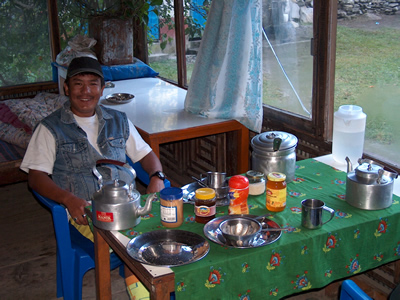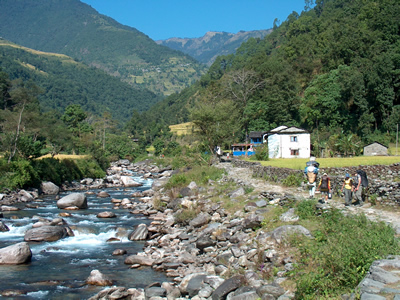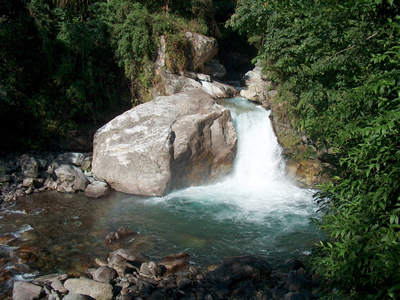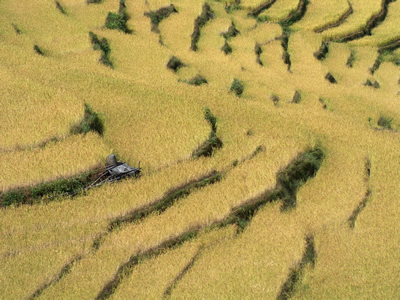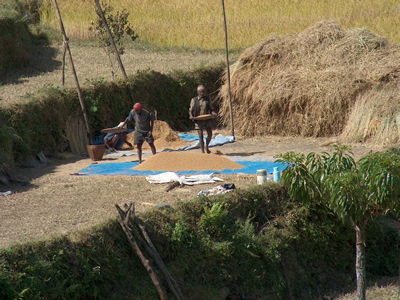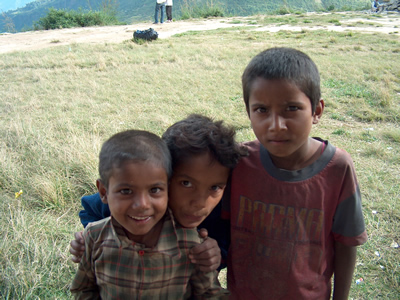Days 1-2 Starting The Trek
On the drive to the trailhead I learned that the guide, Sambhu, preferred to go by his nickname, Tasi. That was fine with me. I figure people should know what their own name is. But it was interesting that no one else used that name. When I referred to "Tasi" in a conversation with Lakpa, the cook on our trip, he didn't know who I was talking about. And Tenzing, the big boss in Kathmandu, always referred to him as Sambhu. But during the trek I called him Tasi. Later he told me that he got the name from the monks in his village when he was a kid growing up and going to school at the monastery.
Tasi said that for our first day the hiking was going to be short. The idea was to start people out gradually. It probably gives the people who run the treks some flexibility so that if they get a person who signed up for a big trek but never even walked to the grocery store, they can find out right away. Having someone collapsing after walking for half an hour wouldn't be good if the camping gear was already many miles further down the trail. Initially we walked along a beautiful river so the trail was pretty flat. That is very rare in Nepal! And the first days hike was indeed short. After only 45 minutes we reached the village of Birethanti. Tasi pointed to a small restaurant and announced that it was where we would stay for the first night. I didn't even get a chance to work up a sweat.
The tents were set up in a small yard behind the restaurant. It was a flat area with grass and had a few trees around it. There was a stone wall that separated it from the main street. The street was really a wide trail. It was possible to reach Biretanthi by jeep but from here on till the end of the trek we would be beyond any roads. I thought it was pretty early to stop but I figured that I had lots of hiking ahead in the next two weeks. So I pulled out my book and read that afternoon. I had brought three books along so nothing to worry about. I even picked paperbacks that had the smallest, densest print I could find. I wanted the most reading for the weight. It always pays to think about weight when everything has to be carried by someone. So I had two Battletech novels and a mystery/love story that Sandy had given me. Light reading.
We had our own cook staff and kitchen gear but we paid a small amount to sit in the restaurant and to camp in the small area in the back. The owner was really fastidious about his camping area. There were trees around the yard and sometimes leaves would fall off. About once an hour he would walk through the yard and pick up loose leaves by hand. I guess he wanted to keep his camping area looking sharp. I just wish he had put as much effort into cleaning the bathroom.
The next morning there was a beautiful view of Machapuchare looking up the river canyon. Now this was what I had come to Nepal to see. It wasn't visible when we had arrived the day before because of clouds. The weather pattern was consistent for the whole trip. Perfectly clear mornings. Clouds starting to form on the mountains sometime after 10 am which would totally cover the mountains by 2 pm. Maybe some clearing at sunset but usually overnight. And always a spectacular view first thing when I got up. It was usually a surprise as the view was typically hidden by the afternoon clouds when we arrived in camp.
We hiked up the river canyon. This was a wide trail which was quite busy since at this point it was on the route for both the Annapurna circuit trek and the Annapurna Sanctuary trek. It was a pretty walk even though we couldn't see the major peaks most of the time. The foothills of the Himalaya are quite steep and would be big mountains most other places. And the Bharanghi Khola (river) was large with lots of cascades and waterfalls as it dropped down the steep canyon.
My next surprise was that it was warm. In fact it was hot. We weren't very high yet, only at about 1000 meters. Within an hour I had taken the legs off my pants. I have two pairs of hiking pants that are convertibles and I don't think that I had ever used them. Most places that I hike I'll usually forgo shorts for the protection against bugs and plants that long pants provide. But it was too warm and there really weren't any bugs (yet) so I was glad that I had convertibles. I had thought about taking a pair of hiking shorts along and had decided that I probably wouldn't need them. Wrong.
It was very pretty sitting by the river while the cook staff made lunch. I took pictures and read and admired the scenery. But it was hot in the sun so by the time lunch was ready Tasi and I moved into someone's house near the trail and had our lunch there. Lunch was good and it was cool and shady inside.
After lunch came my next surprise - we left the main trail. We crossed the Bharanghi Khola and headed up a steep local trail toward the village of Bukka. Well, steep goes without saying. From now on to save typing, if I say "trail" assume that it is "steep trail". In fact often the trails resembled stone stairways more than trails. I have a suspicion that a long time ago someone mistakenly translated the nepali word for "stairway" to the english word "trail". The trails are always going either up or down. A flat trail in the Nepal hill country is pretty rare.
That afternoon we did about a 3000 foot climb up to the village of Bukka. The hillside was very steep but most of it was terraced and covered with rice fields. These fields belonged to the people of Bukka - most of them made their living from farming. The rice terraces curved around the hillsides and were green and gold colors. It reminded me of the patterns of some of the lavender fields that we had seen in the hills of Provence. People were working in the fields harvesting the rice, beating it to get the rice grains, and setting them out to dry in the sun. They had a heck of a commute, walking up and down the hills to reach their fields from the village.
Part way up the hill we stopped for a rest. Because it was warm I found a shady spot with some cool, damp (from a spring) rocks and was taking it easy and enjoying the view. When we started again Tasi was behind me and quickly called my attentiont to a problem - I had a small leech on my leg. I guess I wasn't the only one who thought I had found a good resting spot. We just picked it off and no harm done, except that the stupid things spray an anticoagulant on the bite. Even though the bite was small it took over 15 minutes for it to stop bleeding. Try looking cool walking up a hill while you are holding a bloody tissue on a bug bite near your ankle. Oh well. That's what I get for switching to shorts. But I had gotten two leech bites on my last trip to Nepal and survived so I figured that I would probably be ok this time as well.
We finally reached the village of Bukka. It was spread out over the hillside so the beginning of the village was 200 or 300 feet lower than the upper part. Not a casual stroll over to your neighbors house. We camped in the yard of the village school. Although it was only a few hours hike from the main tourist trail in the area, almost no trekkers come this way. So we were somewhat of a local event. All the kids in the village came to watch our campsite get set up. And most of them seemed to think that I was pretty interesting even though I was just sitting and reading my book. I guess it is pretty rare for them to see Westerners. One of the kids who looked to be about twelve came over to talk to me for a few minutes. He knew some english from school so we chatted and he told me his name was Arin. He mentioned that his younger brother was sick and wondered if I had any medicine, but unfortunately all I had was aspirin and stuff for stomach problems. He came by our camp the next morning and when I called him by name he seemed really pleased that I recognized and remembered him.
In the evening the kids lost interest in us. There was a big volleyball game in progress on the other side of the school building and everyone was there, either playing or watching the game. Volleyball seems to be the big sport in Nepal, at least in the hill country. Many villages we went through on the trek had basketball courts next to the village school. But they always had volleyball nets strung across them. I never saw anyone playing basketball but volleyball games seemed to be common in the evening. Lots of nepalis talked about football (that's football as in soccer) but I never saw a game. It didn't seem like there was a big enough flat area for a soccer field anywhere in the hills. So volleyball seemed to be the game of choice.
When it got dark I could see a very big change since my first trip to Nepal - electric lights. In 1991 I had hiked in the mountains for seven weeks and only been to two villages that had electricity. It was supplied by diesel generator and was only on for about two hours in the evening. Now most of the villages, at least in this area, had very small hydro generators. At night I could see lights in the villages all along the valley heading up to the Annapurna Range. Definitely an improvement in the lives of the people there.
After two days I really felt like the trek had started.
